Marketing Case Study Analysis: SUV Cars and Australian Demographics
VerifiedAdded on 2022/09/22
|11
|2498
|23
Case Study
AI Summary
This case study analyzes the marketing strategies of SUV cars in Australia, focusing on the impact of changing demographics on the automotive industry. It examines how shifts in the Australian population, such as the decline in family households and the rise in single-person households, necessitate adjustments in marketing approaches. The analysis covers the definition of marketing, the demographic changes, and their impact on marketing strategies. It explores macro-environmental factors using Porter's Five Forces to assess industry competitiveness and identifies value creation strategies for customers, emphasizing aspects like comfort and affordability. The study concludes that adapting marketing strategies to reflect evolving demographics is crucial for success in the Australian automotive market, particularly for SUV car marketers, to effectively target consumers and maintain a competitive edge.
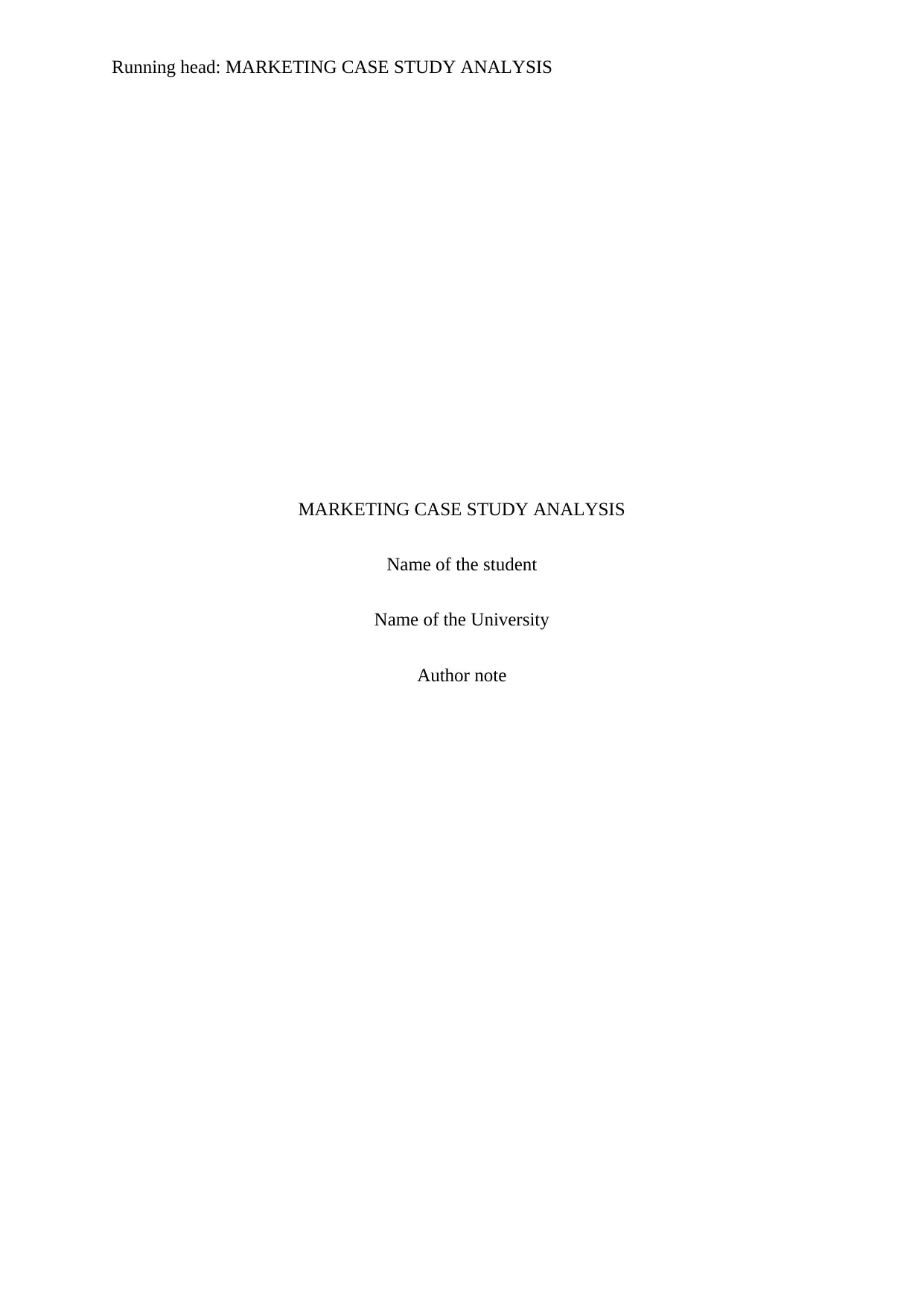
Running head: MARKETING CASE STUDY ANALYSIS
MARKETING CASE STUDY ANALYSIS
Name of the student
Name of the University
Author note
MARKETING CASE STUDY ANALYSIS
Name of the student
Name of the University
Author note
Paraphrase This Document
Need a fresh take? Get an instant paraphrase of this document with our AI Paraphraser

1MARKETING CASE STUDY ANALYSIS
Introduction
The changing scenarios in the business environments throughout the world require the
business organizations operating within their scope to consistently engage in effective
decision making and strategy implementation processes so that they may be able to remain
competitive in the market. there are various aspects that are to be considered by these
business organization for the purpose of gaining and maintaining a competitive advantage.
One of such aspects pertains to the scope of marketing (Mason, Kjellberg and Hagberg 2015).
The process of marketing refers to the business processes and activities that are aimed
towards the identification, anticipation and satisfaction of the needs and demands of the
customers. in other words, it may be said that marketing refers to the identification of the
group or segment of customers to whom the products and services of the business
organization are offered and also devise effective means so that the sale of these products and
services can be induced by attracting the customers. In this regard, it may also be mentioned
that the various important elements associated with the process and management of
marketing in business organizations include the development of new products and services to
suit the needs and changing preferences of the customers, inducing an increase in sales of the
products and services offered by the organization, recognition of the brand of the
organization in the market in which it operates and propelling cost savings (Baker 2014). The
essay will further highlight upon the analysis of the case study on the marketing of SUV cars
in Australia with respect to the changing dynamics of the Australian population. Furthermore,
the broader macro-environmental factors to be considered for the marketers of the country
will be examined as well as the method in which value may be created for the customers to
induce sales of the cars.
Introduction
The changing scenarios in the business environments throughout the world require the
business organizations operating within their scope to consistently engage in effective
decision making and strategy implementation processes so that they may be able to remain
competitive in the market. there are various aspects that are to be considered by these
business organization for the purpose of gaining and maintaining a competitive advantage.
One of such aspects pertains to the scope of marketing (Mason, Kjellberg and Hagberg 2015).
The process of marketing refers to the business processes and activities that are aimed
towards the identification, anticipation and satisfaction of the needs and demands of the
customers. in other words, it may be said that marketing refers to the identification of the
group or segment of customers to whom the products and services of the business
organization are offered and also devise effective means so that the sale of these products and
services can be induced by attracting the customers. In this regard, it may also be mentioned
that the various important elements associated with the process and management of
marketing in business organizations include the development of new products and services to
suit the needs and changing preferences of the customers, inducing an increase in sales of the
products and services offered by the organization, recognition of the brand of the
organization in the market in which it operates and propelling cost savings (Baker 2014). The
essay will further highlight upon the analysis of the case study on the marketing of SUV cars
in Australia with respect to the changing dynamics of the Australian population. Furthermore,
the broader macro-environmental factors to be considered for the marketers of the country
will be examined as well as the method in which value may be created for the customers to
induce sales of the cars.
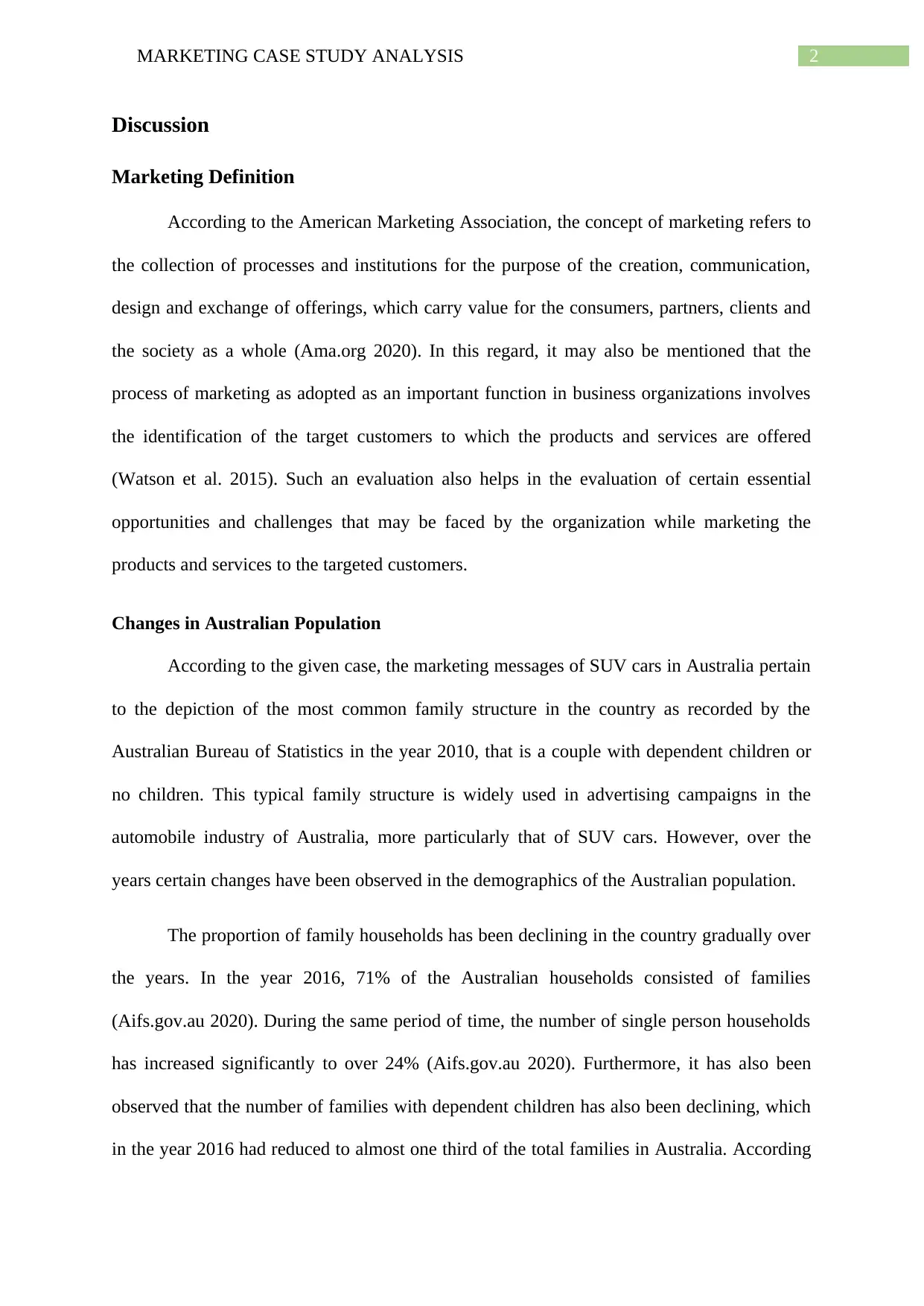
2MARKETING CASE STUDY ANALYSIS
Discussion
Marketing Definition
According to the American Marketing Association, the concept of marketing refers to
the collection of processes and institutions for the purpose of the creation, communication,
design and exchange of offerings, which carry value for the consumers, partners, clients and
the society as a whole (Ama.org 2020). In this regard, it may also be mentioned that the
process of marketing as adopted as an important function in business organizations involves
the identification of the target customers to which the products and services are offered
(Watson et al. 2015). Such an evaluation also helps in the evaluation of certain essential
opportunities and challenges that may be faced by the organization while marketing the
products and services to the targeted customers.
Changes in Australian Population
According to the given case, the marketing messages of SUV cars in Australia pertain
to the depiction of the most common family structure in the country as recorded by the
Australian Bureau of Statistics in the year 2010, that is a couple with dependent children or
no children. This typical family structure is widely used in advertising campaigns in the
automobile industry of Australia, more particularly that of SUV cars. However, over the
years certain changes have been observed in the demographics of the Australian population.
The proportion of family households has been declining in the country gradually over
the years. In the year 2016, 71% of the Australian households consisted of families
(Aifs.gov.au 2020). During the same period of time, the number of single person households
has increased significantly to over 24% (Aifs.gov.au 2020). Furthermore, it has also been
observed that the number of families with dependent children has also been declining, which
in the year 2016 had reduced to almost one third of the total families in Australia. According
Discussion
Marketing Definition
According to the American Marketing Association, the concept of marketing refers to
the collection of processes and institutions for the purpose of the creation, communication,
design and exchange of offerings, which carry value for the consumers, partners, clients and
the society as a whole (Ama.org 2020). In this regard, it may also be mentioned that the
process of marketing as adopted as an important function in business organizations involves
the identification of the target customers to which the products and services are offered
(Watson et al. 2015). Such an evaluation also helps in the evaluation of certain essential
opportunities and challenges that may be faced by the organization while marketing the
products and services to the targeted customers.
Changes in Australian Population
According to the given case, the marketing messages of SUV cars in Australia pertain
to the depiction of the most common family structure in the country as recorded by the
Australian Bureau of Statistics in the year 2010, that is a couple with dependent children or
no children. This typical family structure is widely used in advertising campaigns in the
automobile industry of Australia, more particularly that of SUV cars. However, over the
years certain changes have been observed in the demographics of the Australian population.
The proportion of family households has been declining in the country gradually over
the years. In the year 2016, 71% of the Australian households consisted of families
(Aifs.gov.au 2020). During the same period of time, the number of single person households
has increased significantly to over 24% (Aifs.gov.au 2020). Furthermore, it has also been
observed that the number of families with dependent children has also been declining, which
in the year 2016 had reduced to almost one third of the total families in Australia. According
⊘ This is a preview!⊘
Do you want full access?
Subscribe today to unlock all pages.

Trusted by 1+ million students worldwide
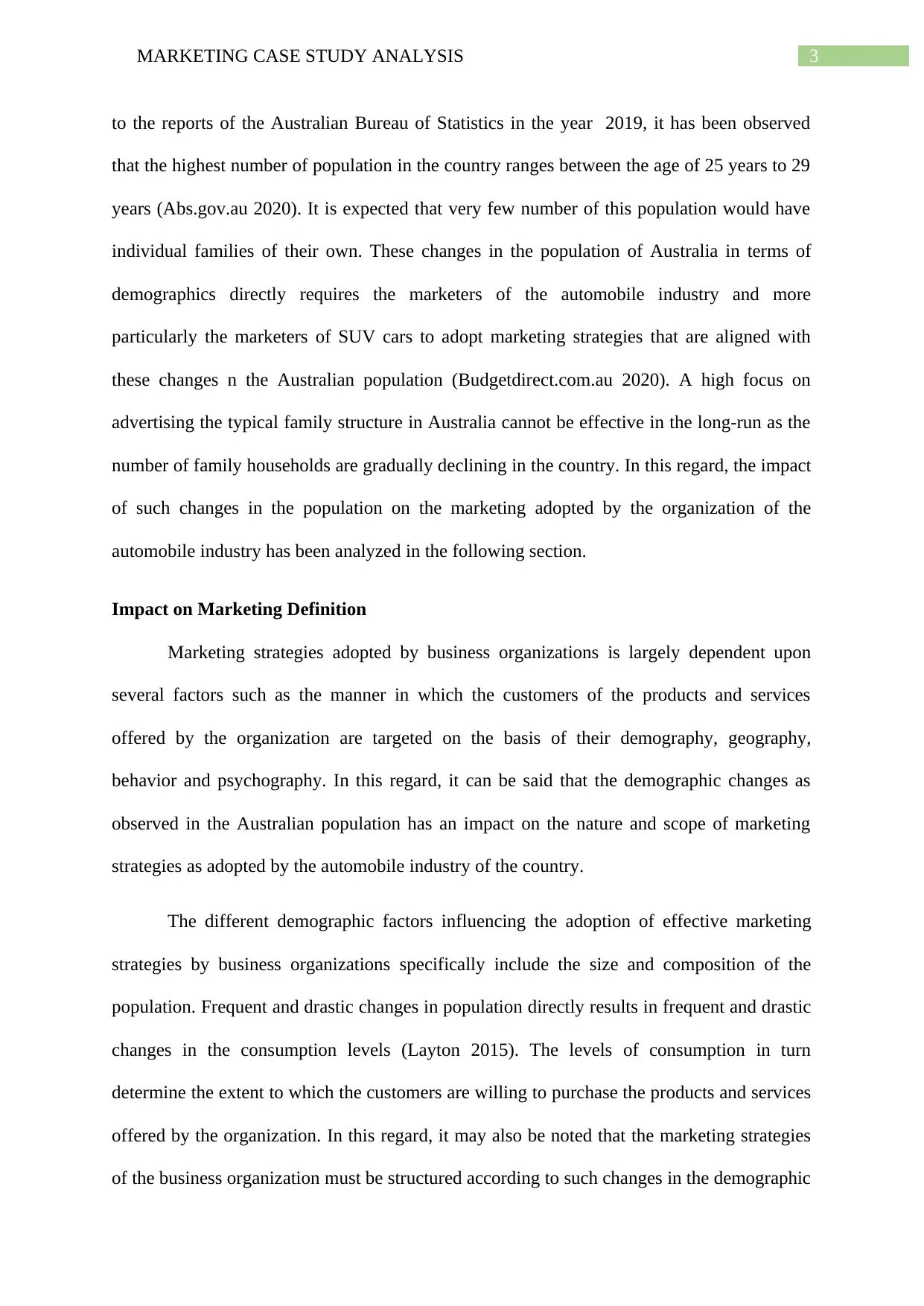
3MARKETING CASE STUDY ANALYSIS
to the reports of the Australian Bureau of Statistics in the year 2019, it has been observed
that the highest number of population in the country ranges between the age of 25 years to 29
years (Abs.gov.au 2020). It is expected that very few number of this population would have
individual families of their own. These changes in the population of Australia in terms of
demographics directly requires the marketers of the automobile industry and more
particularly the marketers of SUV cars to adopt marketing strategies that are aligned with
these changes n the Australian population (Budgetdirect.com.au 2020). A high focus on
advertising the typical family structure in Australia cannot be effective in the long-run as the
number of family households are gradually declining in the country. In this regard, the impact
of such changes in the population on the marketing adopted by the organization of the
automobile industry has been analyzed in the following section.
Impact on Marketing Definition
Marketing strategies adopted by business organizations is largely dependent upon
several factors such as the manner in which the customers of the products and services
offered by the organization are targeted on the basis of their demography, geography,
behavior and psychography. In this regard, it can be said that the demographic changes as
observed in the Australian population has an impact on the nature and scope of marketing
strategies as adopted by the automobile industry of the country.
The different demographic factors influencing the adoption of effective marketing
strategies by business organizations specifically include the size and composition of the
population. Frequent and drastic changes in population directly results in frequent and drastic
changes in the consumption levels (Layton 2015). The levels of consumption in turn
determine the extent to which the customers are willing to purchase the products and services
offered by the organization. In this regard, it may also be noted that the marketing strategies
of the business organization must be structured according to such changes in the demographic
to the reports of the Australian Bureau of Statistics in the year 2019, it has been observed
that the highest number of population in the country ranges between the age of 25 years to 29
years (Abs.gov.au 2020). It is expected that very few number of this population would have
individual families of their own. These changes in the population of Australia in terms of
demographics directly requires the marketers of the automobile industry and more
particularly the marketers of SUV cars to adopt marketing strategies that are aligned with
these changes n the Australian population (Budgetdirect.com.au 2020). A high focus on
advertising the typical family structure in Australia cannot be effective in the long-run as the
number of family households are gradually declining in the country. In this regard, the impact
of such changes in the population on the marketing adopted by the organization of the
automobile industry has been analyzed in the following section.
Impact on Marketing Definition
Marketing strategies adopted by business organizations is largely dependent upon
several factors such as the manner in which the customers of the products and services
offered by the organization are targeted on the basis of their demography, geography,
behavior and psychography. In this regard, it can be said that the demographic changes as
observed in the Australian population has an impact on the nature and scope of marketing
strategies as adopted by the automobile industry of the country.
The different demographic factors influencing the adoption of effective marketing
strategies by business organizations specifically include the size and composition of the
population. Frequent and drastic changes in population directly results in frequent and drastic
changes in the consumption levels (Layton 2015). The levels of consumption in turn
determine the extent to which the customers are willing to purchase the products and services
offered by the organization. In this regard, it may also be noted that the marketing strategies
of the business organization must be structured according to such changes in the demographic
Paraphrase This Document
Need a fresh take? Get an instant paraphrase of this document with our AI Paraphraser
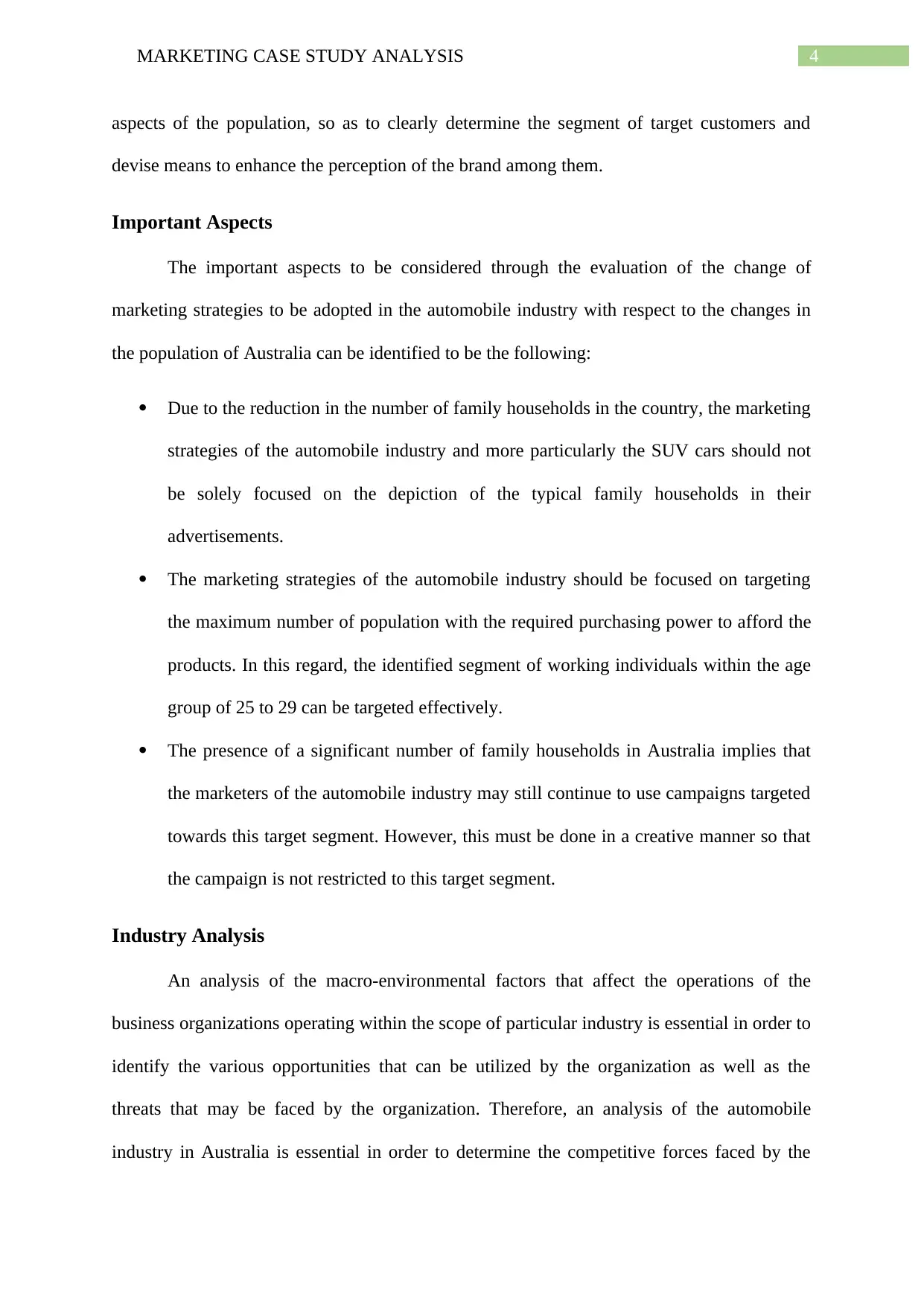
4MARKETING CASE STUDY ANALYSIS
aspects of the population, so as to clearly determine the segment of target customers and
devise means to enhance the perception of the brand among them.
Important Aspects
The important aspects to be considered through the evaluation of the change of
marketing strategies to be adopted in the automobile industry with respect to the changes in
the population of Australia can be identified to be the following:
Due to the reduction in the number of family households in the country, the marketing
strategies of the automobile industry and more particularly the SUV cars should not
be solely focused on the depiction of the typical family households in their
advertisements.
The marketing strategies of the automobile industry should be focused on targeting
the maximum number of population with the required purchasing power to afford the
products. In this regard, the identified segment of working individuals within the age
group of 25 to 29 can be targeted effectively.
The presence of a significant number of family households in Australia implies that
the marketers of the automobile industry may still continue to use campaigns targeted
towards this target segment. However, this must be done in a creative manner so that
the campaign is not restricted to this target segment.
Industry Analysis
An analysis of the macro-environmental factors that affect the operations of the
business organizations operating within the scope of particular industry is essential in order to
identify the various opportunities that can be utilized by the organization as well as the
threats that may be faced by the organization. Therefore, an analysis of the automobile
industry in Australia is essential in order to determine the competitive forces faced by the
aspects of the population, so as to clearly determine the segment of target customers and
devise means to enhance the perception of the brand among them.
Important Aspects
The important aspects to be considered through the evaluation of the change of
marketing strategies to be adopted in the automobile industry with respect to the changes in
the population of Australia can be identified to be the following:
Due to the reduction in the number of family households in the country, the marketing
strategies of the automobile industry and more particularly the SUV cars should not
be solely focused on the depiction of the typical family households in their
advertisements.
The marketing strategies of the automobile industry should be focused on targeting
the maximum number of population with the required purchasing power to afford the
products. In this regard, the identified segment of working individuals within the age
group of 25 to 29 can be targeted effectively.
The presence of a significant number of family households in Australia implies that
the marketers of the automobile industry may still continue to use campaigns targeted
towards this target segment. However, this must be done in a creative manner so that
the campaign is not restricted to this target segment.
Industry Analysis
An analysis of the macro-environmental factors that affect the operations of the
business organizations operating within the scope of particular industry is essential in order to
identify the various opportunities that can be utilized by the organization as well as the
threats that may be faced by the organization. Therefore, an analysis of the automobile
industry in Australia is essential in order to determine the competitive forces faced by the
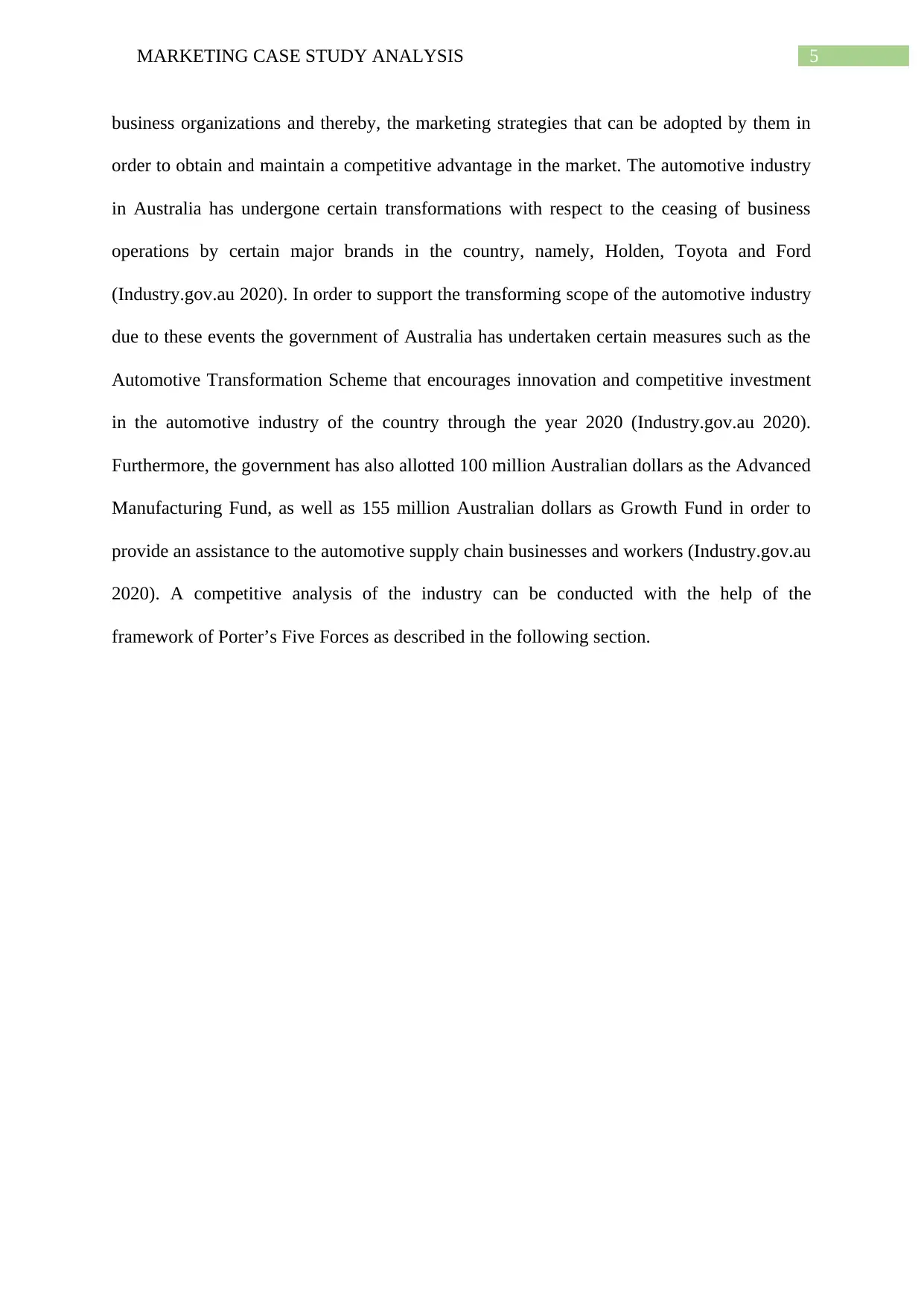
5MARKETING CASE STUDY ANALYSIS
business organizations and thereby, the marketing strategies that can be adopted by them in
order to obtain and maintain a competitive advantage in the market. The automotive industry
in Australia has undergone certain transformations with respect to the ceasing of business
operations by certain major brands in the country, namely, Holden, Toyota and Ford
(Industry.gov.au 2020). In order to support the transforming scope of the automotive industry
due to these events the government of Australia has undertaken certain measures such as the
Automotive Transformation Scheme that encourages innovation and competitive investment
in the automotive industry of the country through the year 2020 (Industry.gov.au 2020).
Furthermore, the government has also allotted 100 million Australian dollars as the Advanced
Manufacturing Fund, as well as 155 million Australian dollars as Growth Fund in order to
provide an assistance to the automotive supply chain businesses and workers (Industry.gov.au
2020). A competitive analysis of the industry can be conducted with the help of the
framework of Porter’s Five Forces as described in the following section.
business organizations and thereby, the marketing strategies that can be adopted by them in
order to obtain and maintain a competitive advantage in the market. The automotive industry
in Australia has undergone certain transformations with respect to the ceasing of business
operations by certain major brands in the country, namely, Holden, Toyota and Ford
(Industry.gov.au 2020). In order to support the transforming scope of the automotive industry
due to these events the government of Australia has undertaken certain measures such as the
Automotive Transformation Scheme that encourages innovation and competitive investment
in the automotive industry of the country through the year 2020 (Industry.gov.au 2020).
Furthermore, the government has also allotted 100 million Australian dollars as the Advanced
Manufacturing Fund, as well as 155 million Australian dollars as Growth Fund in order to
provide an assistance to the automotive supply chain businesses and workers (Industry.gov.au
2020). A competitive analysis of the industry can be conducted with the help of the
framework of Porter’s Five Forces as described in the following section.
⊘ This is a preview!⊘
Do you want full access?
Subscribe today to unlock all pages.

Trusted by 1+ million students worldwide

6MARKETING CASE STUDY ANALYSIS
Threat of Substitutes
The industry faces moderate threat in terms of the substitutes.
It is so because the increasing awareness and consciousness
of the customers regarding the environment have led them to
adopt sustainable means of travelling such as resorting to
public transport (Budgetdirect.com.au 2020). These other
forms of commutation provide the automotive industry with a
certain amount of threat as the customers would not be
inclined to own personal vehicles for each individual
household, thereby reducing the sales.
Competitive rivalry
There is a high threat of competitive rivalry in the automotive industry of Australia. It
is so because the developmental measures undertaken by the government of the country
enables all the organization working in its scope to ideate and innovate new methods of
developing the industry. Such motivation is provided by the government to the business
organizations in the form of funds and other schemes which aid in the efficient
development of the industry.
Threat of new entrants
The organizations operating in the automotive industry of
Australia have low threat of new entrants due to the huge
amount of investments required to set up business
operations in this industry. However, the gradual
reduction of export taxes have attracted a significant
amount of foreign car manufacturers to export their
products in the country at low process, provide a certain
level of competition to the organizations operating in the
country.
Bargaining power of suppliers
The industry faces low threat from the
bargaining power of the suppliers due to the
presence of limited number of organizations in
the industry and larger number of suppliers as
compared to that. Therefore, in this regard, the
organizations have an upper hand on the
suppliers.
Bargaining power of the customers
the automotive industry of Australia faces
moderate threat from the bargaining power of the
customers because in the present age of rapid
globalization, the customers have the availability of
choosing alternatives from among the low priced
foreign competitors. Furthermore, the customers
are technology aware enough to be able to compare
the different process and quality of products offered
by different brands.
Porter’s Five Forces Analysis
Threat of Substitutes
The industry faces moderate threat in terms of the substitutes.
It is so because the increasing awareness and consciousness
of the customers regarding the environment have led them to
adopt sustainable means of travelling such as resorting to
public transport (Budgetdirect.com.au 2020). These other
forms of commutation provide the automotive industry with a
certain amount of threat as the customers would not be
inclined to own personal vehicles for each individual
household, thereby reducing the sales.
Competitive rivalry
There is a high threat of competitive rivalry in the automotive industry of Australia. It
is so because the developmental measures undertaken by the government of the country
enables all the organization working in its scope to ideate and innovate new methods of
developing the industry. Such motivation is provided by the government to the business
organizations in the form of funds and other schemes which aid in the efficient
development of the industry.
Threat of new entrants
The organizations operating in the automotive industry of
Australia have low threat of new entrants due to the huge
amount of investments required to set up business
operations in this industry. However, the gradual
reduction of export taxes have attracted a significant
amount of foreign car manufacturers to export their
products in the country at low process, provide a certain
level of competition to the organizations operating in the
country.
Bargaining power of suppliers
The industry faces low threat from the
bargaining power of the suppliers due to the
presence of limited number of organizations in
the industry and larger number of suppliers as
compared to that. Therefore, in this regard, the
organizations have an upper hand on the
suppliers.
Bargaining power of the customers
the automotive industry of Australia faces
moderate threat from the bargaining power of the
customers because in the present age of rapid
globalization, the customers have the availability of
choosing alternatives from among the low priced
foreign competitors. Furthermore, the customers
are technology aware enough to be able to compare
the different process and quality of products offered
by different brands.
Porter’s Five Forces Analysis
Paraphrase This Document
Need a fresh take? Get an instant paraphrase of this document with our AI Paraphraser

7MARKETING CASE STUDY ANALYSIS
Value Creation
Value creation to the customers is one of the most essential functions of marketing
that is undertaken by business organizations for the purpose if enhancing the perception of
the brand in its target market. The concept of value creation can therefore be defined as the
process by which outputs are created for the customers in a more valuable manner than the
inputs (Bettencourt, Lusch and Vargo 2014). The new marketing strategies to be adopted by
the automotive industry for the purpose of creating value to the customers can be listed as the
following:
Focusing the advertisement and marketing on important aspects of the cars like
comfort in terms of seating or climate control, instead of prioritizing family
orientedness.
Enhancing the affordability of the cars in order to remain competitive with the foreign
automotive companies.
Investments in innovation and advancement of technology to improve the fuel
efficiency of the cars so that the targeted customers may not resort to public transport
substitutes.
Conclusion
From the above discussion regarding the automotive industry in Australia, it can be
deduced that changes in the population or its demographic aspects can influence changes in
the marketing strategies adopted by business organizations operating in the industry. Such
changes in marketing strategies can be decided upon through an evaluation of the external
environment of the industry. Furthermore, the marketing strategies are to be adopted in
manner that they create maximum value for the customers.
Value Creation
Value creation to the customers is one of the most essential functions of marketing
that is undertaken by business organizations for the purpose if enhancing the perception of
the brand in its target market. The concept of value creation can therefore be defined as the
process by which outputs are created for the customers in a more valuable manner than the
inputs (Bettencourt, Lusch and Vargo 2014). The new marketing strategies to be adopted by
the automotive industry for the purpose of creating value to the customers can be listed as the
following:
Focusing the advertisement and marketing on important aspects of the cars like
comfort in terms of seating or climate control, instead of prioritizing family
orientedness.
Enhancing the affordability of the cars in order to remain competitive with the foreign
automotive companies.
Investments in innovation and advancement of technology to improve the fuel
efficiency of the cars so that the targeted customers may not resort to public transport
substitutes.
Conclusion
From the above discussion regarding the automotive industry in Australia, it can be
deduced that changes in the population or its demographic aspects can influence changes in
the marketing strategies adopted by business organizations operating in the industry. Such
changes in marketing strategies can be decided upon through an evaluation of the external
environment of the industry. Furthermore, the marketing strategies are to be adopted in
manner that they create maximum value for the customers.

8MARKETING CASE STUDY ANALYSIS
⊘ This is a preview!⊘
Do you want full access?
Subscribe today to unlock all pages.

Trusted by 1+ million students worldwide

9MARKETING CASE STUDY ANALYSIS
References
Abs.gov.au, 2020. 3101.0 - Australian Demographic Statistics, Jun 2019. [online]
Abs.gov.au. Available at:
<https://www.abs.gov.au/ausstats/abs@.nsf/0/1CD2B1952AFC5E7ACA257298000F2E76?
OpenDocument> [Accessed 14 April 2020].
Aifs.gov.au, 2020. Population And Households. [online] Australian Institute of Family
Studies. Available at: <https://aifs.gov.au/facts-and-figures/population-and-households>
[Accessed 14 April 2020].
Ama.org, 2020. What Is Marketing? — The Definition Of Marketing — AMA. [online]
American Marketing Association. Available at: <https://www.ama.org/the-definition-of-
marketing-what-is-marketing/> [Accessed 14 April 2020].
Baker, M.J., 2014. Marketing strategy and management. Macmillan International Higher
Education.
Bettencourt, L.A., Lusch, R.F. and Vargo, S.L., 2014. A service lens on value creation:
marketing's role in achieving strategic advantage. California management review, 57(1),
pp.44-66.
Budgetdirect.com.au, 2020. Australian Car Sales Statistics 2019. [online] Budget Direct.
Available at: <https://www.budgetdirect.com.au/car-insurance/research/australian-car-sales-
statistics.html> [Accessed 14 April 2020].
Dobbs, M.E., 2014. Guidelines for applying Porter's five forces framework: a set of industry
analysis templates. Competitiveness Review.
Industry.gov.au, 2020. Transitioning Australia’S Automotive Manufacturing Industry.
[online] Department of Industry, Science, Energy and Resources. Available at:
References
Abs.gov.au, 2020. 3101.0 - Australian Demographic Statistics, Jun 2019. [online]
Abs.gov.au. Available at:
<https://www.abs.gov.au/ausstats/abs@.nsf/0/1CD2B1952AFC5E7ACA257298000F2E76?
OpenDocument> [Accessed 14 April 2020].
Aifs.gov.au, 2020. Population And Households. [online] Australian Institute of Family
Studies. Available at: <https://aifs.gov.au/facts-and-figures/population-and-households>
[Accessed 14 April 2020].
Ama.org, 2020. What Is Marketing? — The Definition Of Marketing — AMA. [online]
American Marketing Association. Available at: <https://www.ama.org/the-definition-of-
marketing-what-is-marketing/> [Accessed 14 April 2020].
Baker, M.J., 2014. Marketing strategy and management. Macmillan International Higher
Education.
Bettencourt, L.A., Lusch, R.F. and Vargo, S.L., 2014. A service lens on value creation:
marketing's role in achieving strategic advantage. California management review, 57(1),
pp.44-66.
Budgetdirect.com.au, 2020. Australian Car Sales Statistics 2019. [online] Budget Direct.
Available at: <https://www.budgetdirect.com.au/car-insurance/research/australian-car-sales-
statistics.html> [Accessed 14 April 2020].
Dobbs, M.E., 2014. Guidelines for applying Porter's five forces framework: a set of industry
analysis templates. Competitiveness Review.
Industry.gov.au, 2020. Transitioning Australia’S Automotive Manufacturing Industry.
[online] Department of Industry, Science, Energy and Resources. Available at:
Paraphrase This Document
Need a fresh take? Get an instant paraphrase of this document with our AI Paraphraser

10MARKETING CASE STUDY ANALYSIS
<https://www.industry.gov.au/funding-and-incentives/transitioning-australias-automotive-
manufacturing-industry> [Accessed 14 April 2020].
Layton, R.A., 2015. Formation, growth, and adaptive change in marketing systems. Journal
of Macromarketing, 35(3), pp.302-319.
Mason, K., Kjellberg, H. and Hagberg, J., 2015. Exploring the performativity of marketing:
theories, practices and devices.
Watson IV, G.F., Worm, S., Palmatier, R.W. and Ganesan, S., 2015. The evolution of
marketing channels: Trends and research directions. Journal of Retailing, 91(4), pp.546-568.
<https://www.industry.gov.au/funding-and-incentives/transitioning-australias-automotive-
manufacturing-industry> [Accessed 14 April 2020].
Layton, R.A., 2015. Formation, growth, and adaptive change in marketing systems. Journal
of Macromarketing, 35(3), pp.302-319.
Mason, K., Kjellberg, H. and Hagberg, J., 2015. Exploring the performativity of marketing:
theories, practices and devices.
Watson IV, G.F., Worm, S., Palmatier, R.W. and Ganesan, S., 2015. The evolution of
marketing channels: Trends and research directions. Journal of Retailing, 91(4), pp.546-568.
1 out of 11
Related Documents
Your All-in-One AI-Powered Toolkit for Academic Success.
+13062052269
info@desklib.com
Available 24*7 on WhatsApp / Email
![[object Object]](/_next/static/media/star-bottom.7253800d.svg)
Unlock your academic potential
Copyright © 2020–2025 A2Z Services. All Rights Reserved. Developed and managed by ZUCOL.





